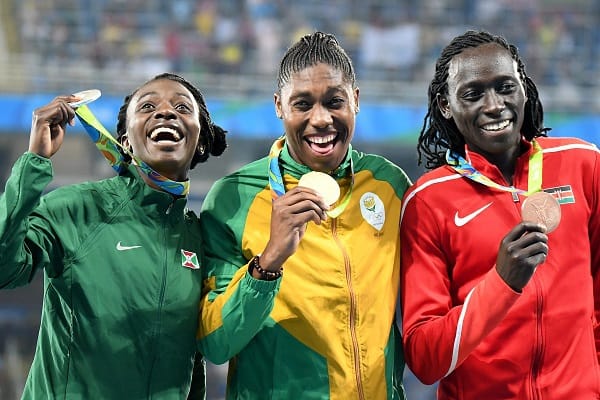Testosterone Ban Inaccuracies Open Debate on the Necessity for Sex Testing in Sports

By Chiara Broglia, MA Linguistics
Ever since women started competing in their own sport category, the sex of female athletes, particularly those capable of exceptional athletic performance, has been questioned. However, only recent developments pointed out the issue with sex testing, highlighting its discriminatory nature and opening a much deeper conversation on the notion of assigned sex. In 1966, female sex testing was introduced at the European Championships of Athletics in Budapest, consisting of genital inspection – conducted by a panel of doctors to verify the athlete’s sex. This test was soon replaced by chromosomal testing. Intersex athletes that qualified as female in 1966, such as Polish sprinter, Ewa Klobukowska, were no longer allowed to compete if they had a different combination of chromosomes. (Which occurs naturally in roughly 1.7% of the population.)
Latest International Olympic Committee guidelines on sex testing put an end to the controversial debate sparked after World’s Athletics events of the last few years, and challenges once again the definition of female.
Testosterone levels as a qualifying criterion was introduced in 2011 – with a limit of 10 nanomoles per litre of blood considered to be the lower end of male testosterone levels by the International Association of Athletics Federation (IAAF). Indian sprinter Dutee Chand, who exceeds this limit, appealed the decision of banning her for her naturally high testosterone levels. The ban was subsequently lifted after the Court of Arbitration for Sport ruled that the IAAF could not demonstrate evidence linking high testosterone levels and increased athletic capabilities.
A new testosterone regulation was again introduced in 2018, with a new limit of 5 nanomoles per litre, but only applied to three track distances: 400m, 800m and 1500m. Following these new guidelines several 2016 Rio Olympic Games’ medal winners were banned from competing, including South African sprinter Caster Semenya. Semenya argued that there was no possibility of taking drugs to modify her natural biological features, fearing that the drugs might interfere with and compromise other biological functions. After Semenya’s appeal was rejected, many in the scientific community spoke in her favour, claiming that it is unethical to administer drugs to a healthy athlete to modify their genetic makeup.
It is also observed that IAAF’s restrictions unfairly target mostly Black female athletes. This new regulation not only directly impacted the South African gold medallist Caster Semenya, but also Burundian silver medallist Francine Niyonsaba, Kenyan bronze medallist Margaret Wambui, Nigerian sprinter Aminatou Senyi, and more recently Namibia’s Christine Mboma and Beatrice Masilingi.
This racial discrimination is further aggravated by the fact that the IAAF’s testing isn’t mandatory for all athletes but that it is only contemplated if an athlete is identified as ‘suspicious.’ This has raised the concern that an athlete might be picked on for testing solely based on a Eurocentric vision of what a woman should look and perform like.
The concerns on ‘suspicious drug testing’ were reiterated by the statement from IAAF official Matthieu Reeb, who described the current testosterone regulation as ‘discrimination that is necessary and reasonable and a proportionate means of achieving the IAAF’s objective as preserving the integrity of female athletics.’
This draws the question of whether the policing of testosterone is really necessary to ensure a fair competition? According to Dr. Richard Holt, professor in diabetes and endocrinology at the University of Southampton: ‘There are a number of genetic polymorphisms, slight changes in the genes, that will actually determine whether somebody has that innate ability to be able to compete at the elite level,’ he explained to the BBC on 7 July 2021. Moreover, there are many factors that contribute to athletic performance, like heart size, bone density and body proportions. The same is claimed by Katrina Karzakis, a bioethicist with Yale University’s Global Health Justice Partnership who argues that singling out testosterone as the defining factor of an athletic performance is inaccurate, unreliable and discriminatory.
We should also question why top male athletes known for their exceptional physical features, aren’t dehumanised by IAAF’s drug testing policy. It is clear that it is rare even among top male swimmers to be targeted, despite having physical advantages, the possibility of banning these athletes from swimming to ensure fair competition was never considered. On the other hand, successful female athletes are constantly asked to prove their biology and are penalised for their natural advantages.
The ground-breaking decision of the IOC that published a set of 10 principles that sports competition should follow and ultimately drop these unfair policy restrictions on testosterone levels seems to confirm that this discrimination isn’t necessary at all. Nevertheless, World Athletics stated that they will maintain their regulations on athletes with differences on sex development. Caster Semenya saw her appeal rejected by the Court of Arbitration for Sport and Switzerland’s Federal Supreme Court and is now awaiting a hearing at the European Court of Human Rights, hoping that she and other banned athletes will be allowed to compete again.
Caption: Semenya, Niyonsaba and Wambui smiling together on the podium in Rio after winning the gold, silver and bronze medals(source: alammy)



